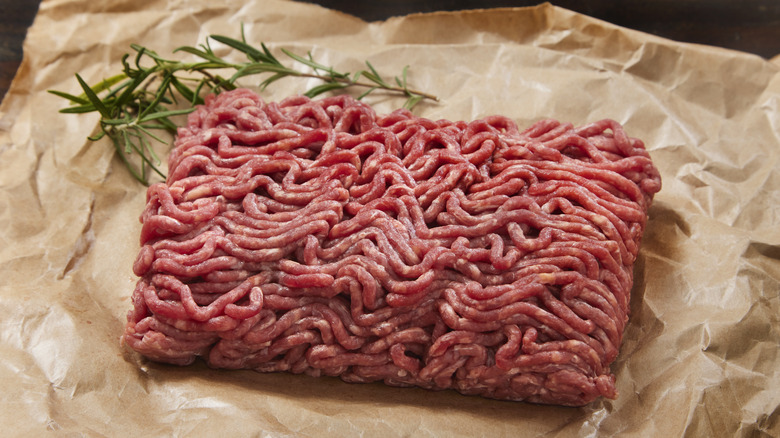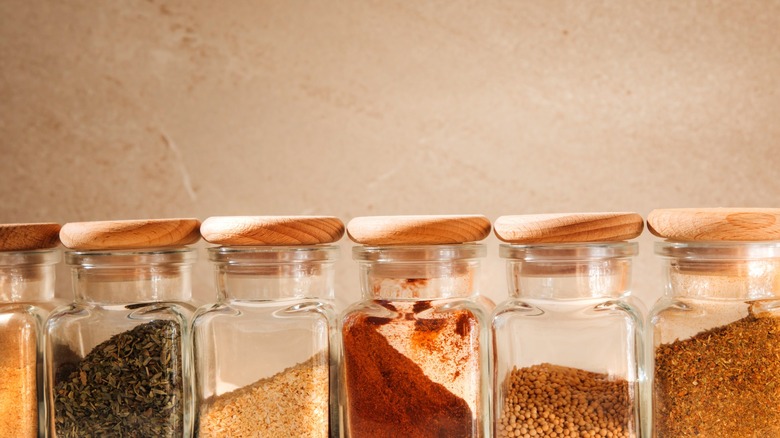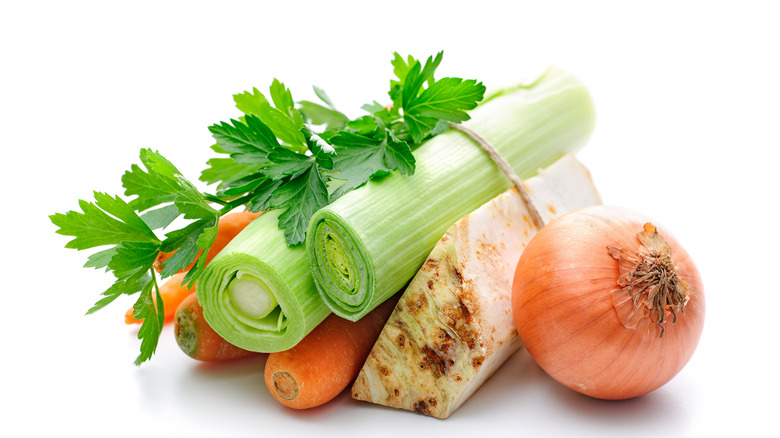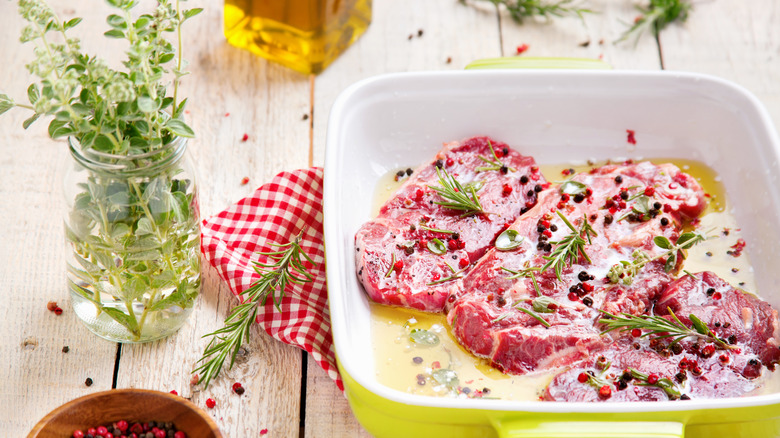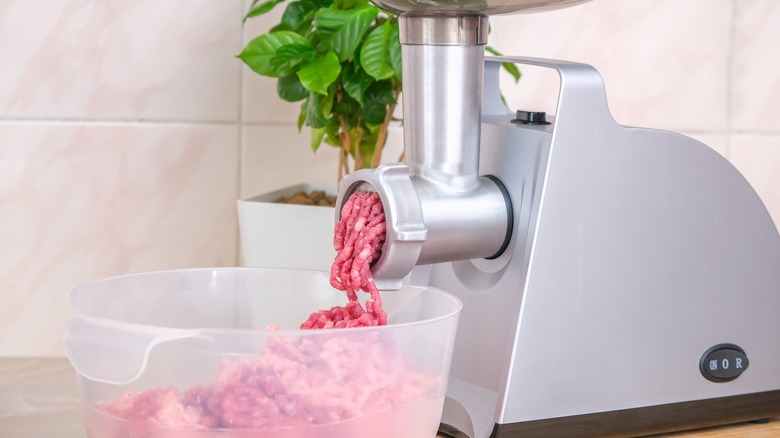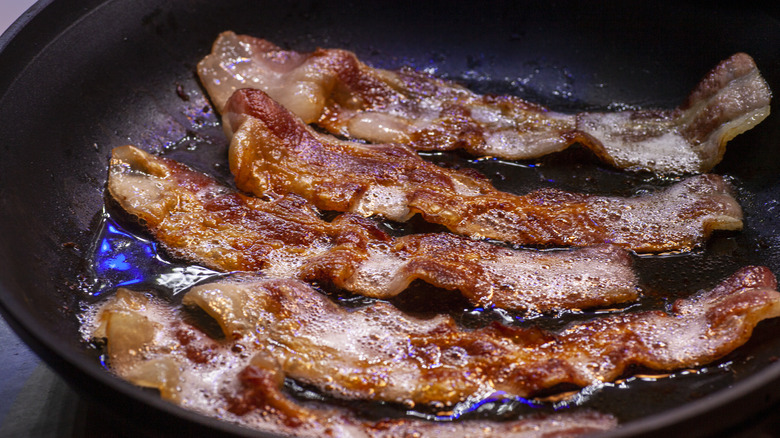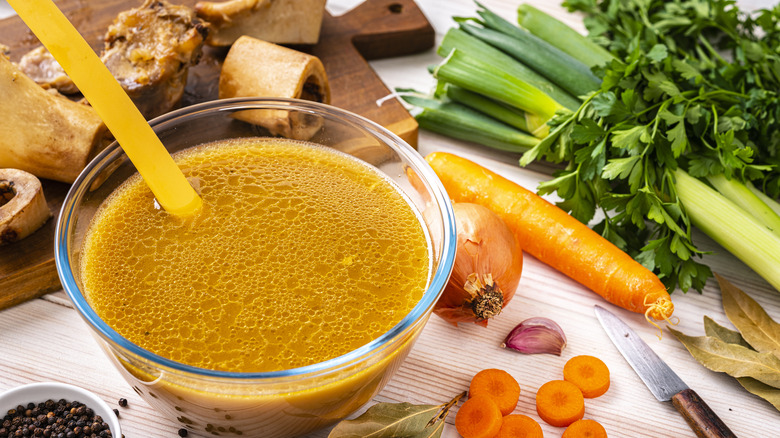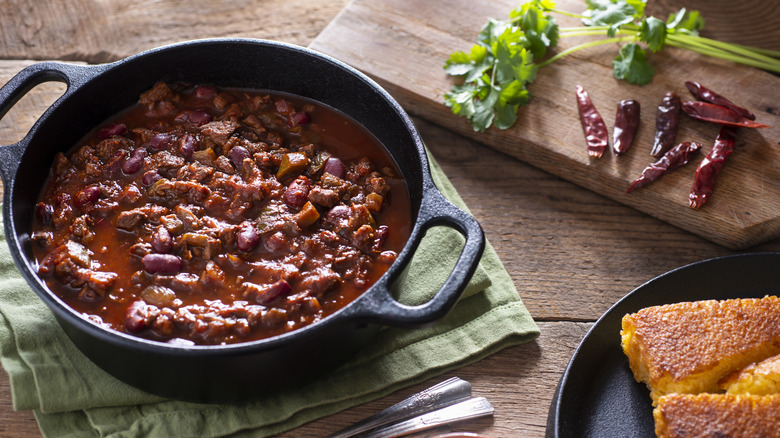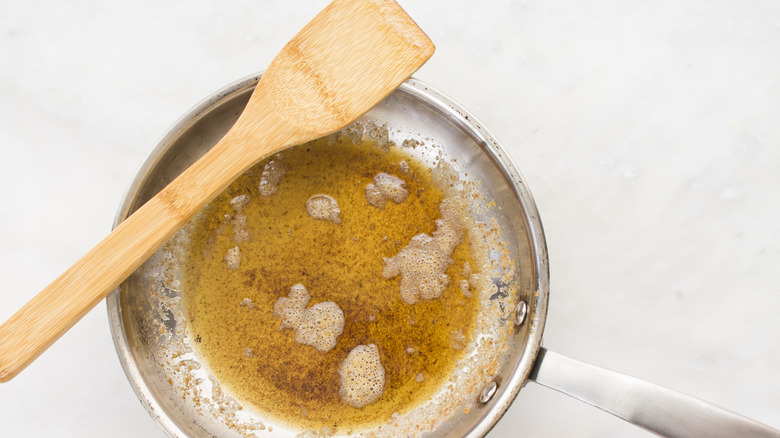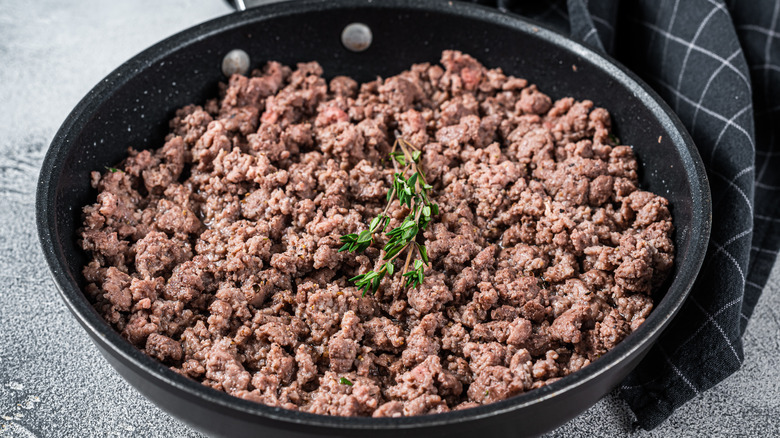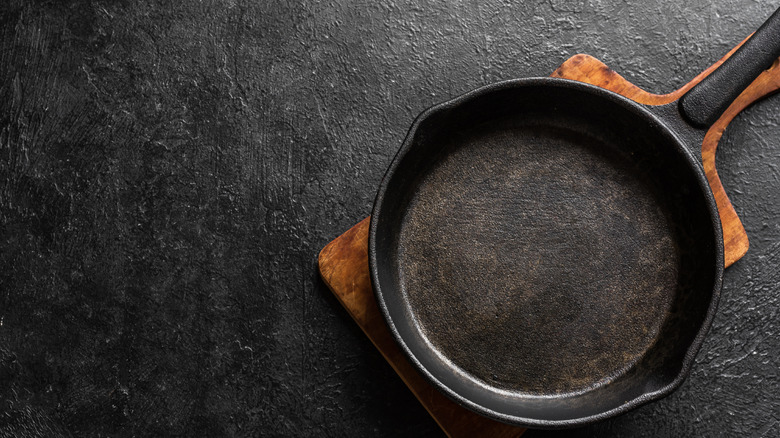12 Tips For Adding More Flavor To Your Ground Beef
Ground beef is a workhorse ingredient. It's affordable, versatile, and easy to spin into myriad dishes from sloppy joes to tacos. It's important to get the maximum amount of flavor from your beef, taking it from a grocery store basic to a superstar staple. Seasoning your beef well with salt is a given, but there are a few go-to techniques for amplifying the natural flavor of your meat and adding layers of spice and ingredients.
Once you add these tips to your kitchen arsenal, you can boost the flavor of your ground beef and take it in any direction depending on how you plan to use it. Eat it alone, and it'll be the best ground beef you've ever made: more tender, perfectly browned, and well-seasoned. Give it an umami boost with smoked paprika and mushroom powder and serve it over rice, or stir in tomato paste and oregano and toss it with fresh pasta. When your meat is this good, there's no end to what you can (and should) do with it: Make it a pizza topping, layer it into lasagna, spoon it over a baked potato, and so on. Start with these basics of building flavor, which focus on small strategies to yield big results.
Lean into your pantry
The biggest impact with minimal effort, flavor-wise, will come from basic spices you probably already have stocked in your pantry. Adding some ground spices like cumin, ground fennel, garlic powder, or even mushroom powder will amplify the savory taste of the beef and add a new flavor profile. You can add the spices early on so that they bloom in the fat while the meat browns. One exception here is salt. Salt draws out moisture and should be added towards the end of cooking.
To get the most bang for your buck, make sure your spices are fresh and high-quality. Higher-quality spices will intensify the amount of flavor. Spices don't last forever; Over time, their potency will drop. Expiration dates aren't the only reliable indicator of freshness here, since their strength will slowly fade over time well before they reach an expiration date. Rely on your senses: Smell and taste the spices to see how strong they are. When selecting spices to flavor your beef, think of complementary pairings. Smoked paprika, garlic, and cumin work well together. Thyme, fennel, and oregano will give an Italian slant, or try cinnamon and chili powder for some heat.
Turn to baking soda
Baking soda is a useful ingredient for much more than just baking, and don't overlook it when cooking meat. Mixing baking soda into your meat before cooking is one small step that pays off hugely in flavor. Add about ¼ teaspoon of baking soda for every pound of ground beef, and let it sit for 15 minutes before cooking.
Baking soda raises the pH balance of the surface of the meat, which prevents the proteins from bonding together as much. When the proteins don't bond as much, less water is released during the cooking process, which translates to less moisture in your meat. Less moisture in turn means better browning: Without all that water, you can achieve deep golden edges on the meat, and color means flavor! Baking soda also works to tenderize the meat, which is especially helpful for large or tough cuts of meat but still improves the quality of your ground beef dishes.
Rely on aromatics
Aromatic vegetables are an excellent way to elevate the flavor of your ground beef. Aromatics refers to a combination of vegetables used to create the foundation of flavor in dishes. Add aromatics at the beginning of cooking, and sweat them (allowing them to soften slightly) in oil before adding your beef to build layers of flavor that will permeate the final dish. Any combination of diced vegetables will enhance the beef's flavor, but you can rely on some tried-and-true culinary powerhouses for the best results.
Try sofrito (a Latin American blend of onions, garlic, peppers, and cilantro), or French mirepoix (celery, carrots, and onion). Don't feel like this needs to add a big step to the cooking process or a lot of prep. Even if you just have one ingredient on hand, like a single onion or an extra carrot, that will make a difference! Chop it up finely, saute it in some oil, then add your beef. You'll notice more depth of flavor in the final dish.
Go for unexpected flavors
Beef is an easy blank canvas for all sorts of flavor profiles. There are some tried-and-true ingredients that are traditionally paired with beef, like Worcestershire sauce and ketchup and steak sauce. These ingredients, along with balsamic vinegar, red wine, and Dijon mustard, are natural matches for the savory, rich taste of beef. While you can stick with the basics, trying a less predictable route will yield a big flavor payoff. A good guiding principle when looking for unexpected flavor options is to consider other dishes made with beef, and use their spice roster, knowing it'll be a pairing that works. Another trick, if you're trying out new flavors for the first time, is to season just a bit of beef with your spices (a spoonful or so) and cook it off in a pan. Taste it and make sure you like it before mixing the ingredients into the rest of your ground beef.
Try Chinese five-spice or a little sugar, fish sauce, soy sauce, and honey for a teriyaki vibe. Turn to the spice aisle for inspiration, and mix in celery salt and coriander seeds, or some dried dill and thyme. Herbs de Provence, or a blend of the same flavors using fresh herbs instead of dried (thyme, marjoram, lavender, fennel, basil, mint, and oregano) is a wonderfully aromatic choice.
Marinate it first
Whether you want to introduce a new flavor profile or amplify the existing flavor of the meat, marinating is a simple step to add to your prep that has a big flavor payoff. Marinating your meat won't tenderize it but it does add moisture, which is more relevant when you're cooking larger, tougher cuts of meat, but still worthwhile with ground beef. A marinade can also work in two ways, both to pre-soak the meat and infuse it with flavor and as a sauce for the final dish.
Marinating in advance allows the flavoring to permeate the surface of the meat. Ground beef has a much smaller surface area to interior ratio, so you can afford to do a quicker marinade (even 15 to 30 minutes will impart flavor) rather than an overnight marinade. Choose your ingredients based on what flavor profile you're after, knowing that each one will infuse your meat with a different taste. Soak it in a Bloody Mary-inspired spiced tomato juice blend, or whip up a simple mix of olive oil, balsamic vinegar, and fresh rosemary. A marinade can do double duty and act as your seasoning step too. Instead of separately seasoning your beef beforehand or during cooking, a properly seasoned marinade will do the job for you, so don't skimp on the salt and pepper.
Use the best quality meat
You can cut corners on some ingredients without a noticeable effect on your final dish, but your protein isn't one of them. If you want a better flavor (rounder, more complex), then opt for the best quality beef you can find. The fattiest cut isn't always the most flavorful, so look for other indicators like the type of cut. A higher fat content will give a richer flavor to your meat and keep it moist, but too much fat and your beef will shrink down too much as the fat cooks off. If you're cooking something that needs to hold its shape, like a burger or beef patty, be mindful of the fat ratio. Most ground beef falls somewhere between an 80/30 and 60/40 ratio of lean meat to fat, with 70/30 being the most common.
Pick up the freshest meat you can for the best flavor. Look for the sell-by date. Find the latest date you can from the meat available to you. That will ensure you're getting the most fresh beef, which will pack the most flavor. If you have one nearby, buy it straight from a trusted butcher. A great butcher will carry the freshest products and can help point you towards the best choice. Even better, buy from the farmers themselves. Your best option for ground beef is, if possible, buying a cut of beef and grinding it yourself.
Mix in other protein
The protein is the main event, so blending in multiple varieties is an excellent strategy for building complexity and richness. Add in another ground meat to layer in more flavor and fat. If ground beef is the star of the meal, then choose a small portion of another protein. You can mix in other meat in any proportion or ratio you want, bearing in mind the texture you're after. For example, if you're cooking a burger, you don't want a blend that is too fatty, or the burger will shrink down too much during cooking.
Consider ground chorizo, for heat and spice, or ground veal or lamb for a richer or more gamey taste. Since amplifying flavor is your goal, stick with proteins that pack a punch rather than meats like turkey or chicken, which don't have strong flavors. A small portion of pancetta or bacon (a wonderful trick for improving your burgers) will give a smokiness and fattiness to your dish without sacrificing texture or shape while cooking.
Double down on beefy flavor
Sometimes more is more. If your aim is to amplify the flavor of your beef, find a way to add other forms of it. You can opt for beef broth in your marinade, either on its own or in combination with other flavors (tomato paste or red wine are natural partners). Or, add more beef in the form of a beef bouillon cube. Using such a concentrated flavor won't affect the texture of your meat, but it will intensify the savory taste of your final dish. Bouillon comes in multiple forms, including pastes and powders, but if using a bouillon cube like Better Than Bouillon, dissolve it in just enough water to create a paste (or use an existing liquid called for in your recipe), then add it to the ground beef during the cooking step.
Soups and stews will call for broth in the ingredient list, but you can try using it (or a bouillon cube) in any application where you really want the beef to be the star. A cube of beef bouillon added to beef stroganoff will intensify the beef flavor. Mix it into meatballs for an extra-savory punch.
Make it a stew
Stews are reliably flavor-packed dishes. The low, slow method of cooking encourages ingredients to meld together and infuse, so your beef will take on more flavor as it cooks. The longer the stew sits, the more flavor will develop because of how the collagen continues to break down over time, per BBC Science Focus. Stews also tend to lean heavily on spice, which will add layers of flavor to your meat. Many stews will also call for stock or broth as a base—using beef broth will introduce another element of beef flavor naturally. Not only that, stews tend to
Recipes like Ethiopian minchet abish build on a foundation of ground beef using spices to create a nuanced and complex dish. And don't overlook chili, which is a stew in its own right: ground beef and beans simmered for hours in a heavily spiced sauce (typically tomato-based). You can also substitute ground beef in a stew calling for another protein, like this moussaka-inspired ground lamb stew that blends feta, eggplant, cinnamon, and basil for a rich and warming meal.
Don't overlook dairy
Ground beef recipes typically call for oil when heating the pan. Instead, consider adding butter along with the oil before cooking the meat to introduce a creamy, rich taste. As the butter melts and begins to brown in the heat, new flavor compounds are created that will introduce serious flavor to your beef. If you've ever tried a side-by-side taste comparison of plain butter and brown butter, you'll know how nuanced and aromatic brown butter is. The savory flavor pairs beautifully with ground beef.
You can also add a spoonful of buttermilk powder to your ground beef as you're cooking it. If your recipe calls for liquid, dissolve it in that liquid first, or stir it into the marinade if you're opting for a marinade. Buttermilk powder adds that same creaminess as butter, plus some tang to cut through the richness of the meat. Or, go big and soak your meat in heavy cream as a dairy-forward marinade.
Don't skip the sear
Browning the meat is one of the first instructions you'll find in most ground beef recipes, so let's dive into what that really means. When a recipe says to brown the meat, it means truly brown: You're aiming for serious color, not just trying to cook the meat in this step. Make sure your pan is hot before adding the meat. If the pan hasn't had time to heat up, the meat will steam rather than brown, resulting in a grayish color.
Once you add the meat, let it sit for a bit before moving it around in the pan to give the protein ample time to make contact with the hot pan. Then use a spatula to flip and stir the meat, giving it time after you move it around to pick up more color. More color means more flavor. When the meat is subjected to high enough heat, it triggers the Maillard reaction, causing proteins and sugars in the meat to create new flavors and aroma molecules. In short, more heat means more flavor.
Cook it in cast iron
So now you know you need to get a really good sear on your beef, and you're aiming for that deep golden color. There's one extra step that will ensure you achieve the proper sear every time, and that's to use a cast iron pan. Consistent, high heat is your friend when it comes to browning beef. For that kind of heat, cast iron is the ideal vessel for cooking.
Cast iron heats up quickly and retains heat better than other pans (like nonstick or stainless steel). It also conducts heat better, ensuring the pan is uniformly hot, so you won't end up with some areas where your beef doesn't brown as well. Make sure you follow the best practices for cooking with cast iron, including preheating the pan and using plenty of oil. And always clean it properly, too; taking care of your cast iron pan ensures that it will remain well-seasoned.
